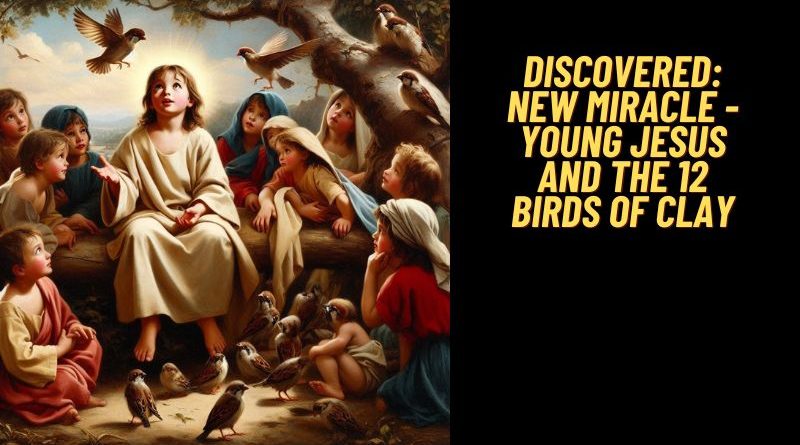Discovered: New Miracle – Young Jesus and the 12 Birds of Clay
Newly deciphered papyrus describes ‘miracle’ performed by 5-year-old Jesus
But what the Book of Thomas fills in: Is it legitimate? Some of it? All of it?
It certainly is interesting.
Among the gems:
“Jesus plays at the ford of a rushing stream and molds twelve sparrows from the soft clay he finds in the mud. When his father Joseph rebukes him and asks why he is doing such things on the holy Sabbath, the five-year-old Jesus claps his hands and brings the clay figures to life,” the press release from the archeologists stated.
“The fragment is of extraordinary interest for research,” Lajos Berkes, a professor and one of the researchers who decoded the document, said in the press release. “On the one hand, because we were able to date it to the 4th to 5th century, making it the earliest known copy. On the other hand, because we were able to gain new insights into the transmission of the text.”
By Owen Jarus
published June 18, 2024
A manuscript written in the fourth or fifth century describes how Jesus brought clay birds to life as a child.

This papyrus fragment from the fourth or fifth century is thought to be a part of the “Infancy Gospel of Thomas.” (Image credit: Staats- und Universitätsbibliothek Hamburg (Public Domain Mark 1.0))
Scholars have deciphered and published a papyrus fragment containing part of the “Infancy Gospel of Thomas,” which tells stories from Jesus‘ childhood.
Written in Greek, the papyrus fragment dates to the fourth or fifth century, making it the earliest copy of this gospel known to exist, scholars wrote in a paper recently published in the journal Zeitschrift für Papyrologie und Epigraphik. Other copies of the gospel exist, but they date to later times. Churches did not include this gospel in the Bible.
It “is the earliest preserved manuscript of the text in any language,” Lajos Berkes, a lecturer at the Institute for Christianity and Antiquity at the Humboldt University of Berlin, and Gabriel Nocchi Macedo, a papyrology professor at the University of Liège in Belgium, wrote in the study. Scholars generally believe that the Infancy Gospel of Thomas was originally composed in the second century. Part of the reason is because some of the stories told in the gospel sound similar to stories that second-century Christian writers wrote about
Childhood miracle
The papyrus fragment tells of a miracle that Jesus performed when he was a child. In the story told in the fragment, “Jesus plays at the ford of a rushing stream and moulds twelve sparrows from the soft clay he finds in the mud. When his father Joseph rebukes him and asks why he is doing such things on the holy Sabbath, the five-year-old Jesus claps his hands and brings the clay figures to life,” according to a statement from Humboldt University of Berlin. Scholars are already aware of this story from later copies of the gospel.
While this fragment mentions only this particular miracle, later copies of the gospel tell of many other miraculous acts that Jesus performed as a child. These include bringing a child named Zeno back to life and instantly healing his father Joseph after he was bitten by a poisonous snake.
Uncertain provenance
The origin of the fragment is uncertain. We “know close to nothing about the provenance of the papyrus, its history and ownership,” Nocchi Macedo told Live Science in an email. “All we know for sure is that it originated in Egypt. It might have arrived in Hamburg either when the core of the papyrological collection was acquired — between 1906 and 1939 — or in 1990 when a box of unconserved papyri was transferred [to Hamburg] from Berlin.” In the study, the scholars said they are confident that the fragment was in Germany prior to World War II.
Sign up for the Live Science daily newsletter now
Get the world’s most fascinating discoveries delivered straight to your inbox.Contact me with news and offers from other Future brandsReceive email from us on behalf of our trusted partners or sponsorsBy submitting your information you agree to the Terms & Conditions and Privacy Policy and are aged 16 or over.
One reason the papyrus wasn’t investigated earlier is that the handwriting is messy, and it looks more like a private letter or shopping list than a gospel, the researchers said in the statement. The scholars think it may have been a writing exercise, possibly done by someone in a school or a monastery.
‘Exciting’ find
Many scholars agree that the fragment is an ancient manuscript and not a modern-day forgery.
“It’s exciting that there’s a new, early manuscript of this text,” Simon Gathercole, a professor of New Testament and early Christianity at the University of Cambridge, told Live Science in an email. “It’s authentic in the sense that this really is an ancient manuscript. It’s not authentic in the sense that it tells us what Jesus really did as a child,” Gathercole said.
Tony Burke, a professor of early Christianity at York University in Toronto, noted that the finding doesn’t provide new information.
“I think it’s great to have more witnesses to the text but it doesn’t tell us anything new,” Burke told Live Science in an email. “We always thought it was composed in the second century, so a 4th/5th century copy does not change the consensus view on the text.”
RELATED STORIES
—The apostles: How Jesus’ followers founded Christianity
—‘Christ’ tattoo discovered on 1,300-year-old body in Sudan
Christopher Frilingos, a religious studies professor at Michigan State University, told Live Science that the discovery is “highly significant, both in terms of the date of the fragment as well as the language, Greek.”
In an email, he noted that “other early Christian writers from the second century allude to childhood stories about Jesus; this manuscript would be the earliest witness to the text of such stories.” Frilingos also noted that the provenance of the text should be examined in greater detail, if possible.
Live Science Contributor
Owen Jarus is a regular contributor to Live Science who writes about archaeology and humans’ past. He has also written for The Independent (UK), The Canadian Press (CP) and The Associated Press (AP), among others. Owen has a bachelor of arts degree from the University of Toronto and a journalism degree from Ryerson University.






A document can be authentic in age, but not necessarily in content.
Quote from the article: “It’s authentic in the sense that this really is an ancient manuscript. It’s not authentic in the sense that it tells us what Jesus really did as a child,” Gathercole said.